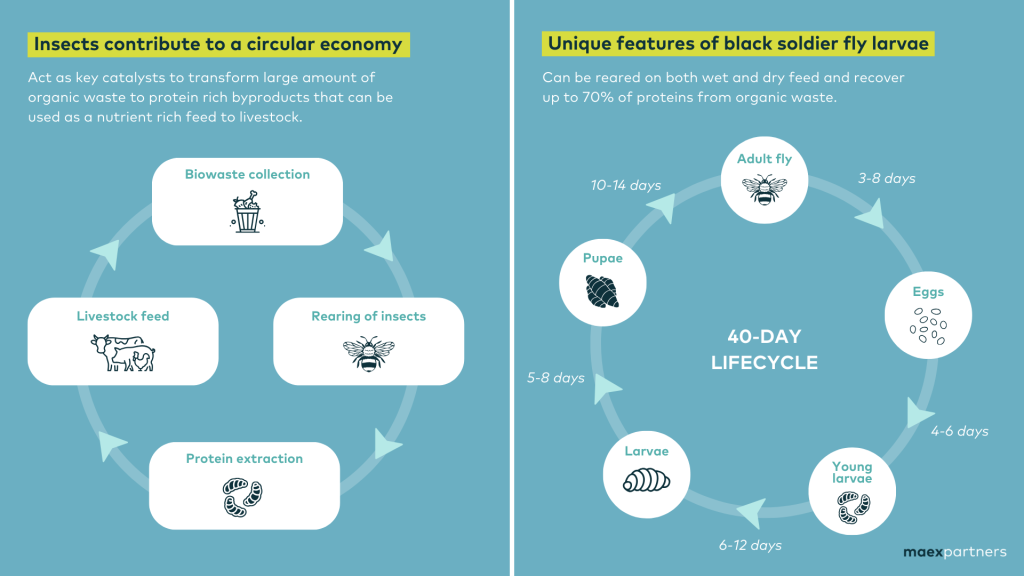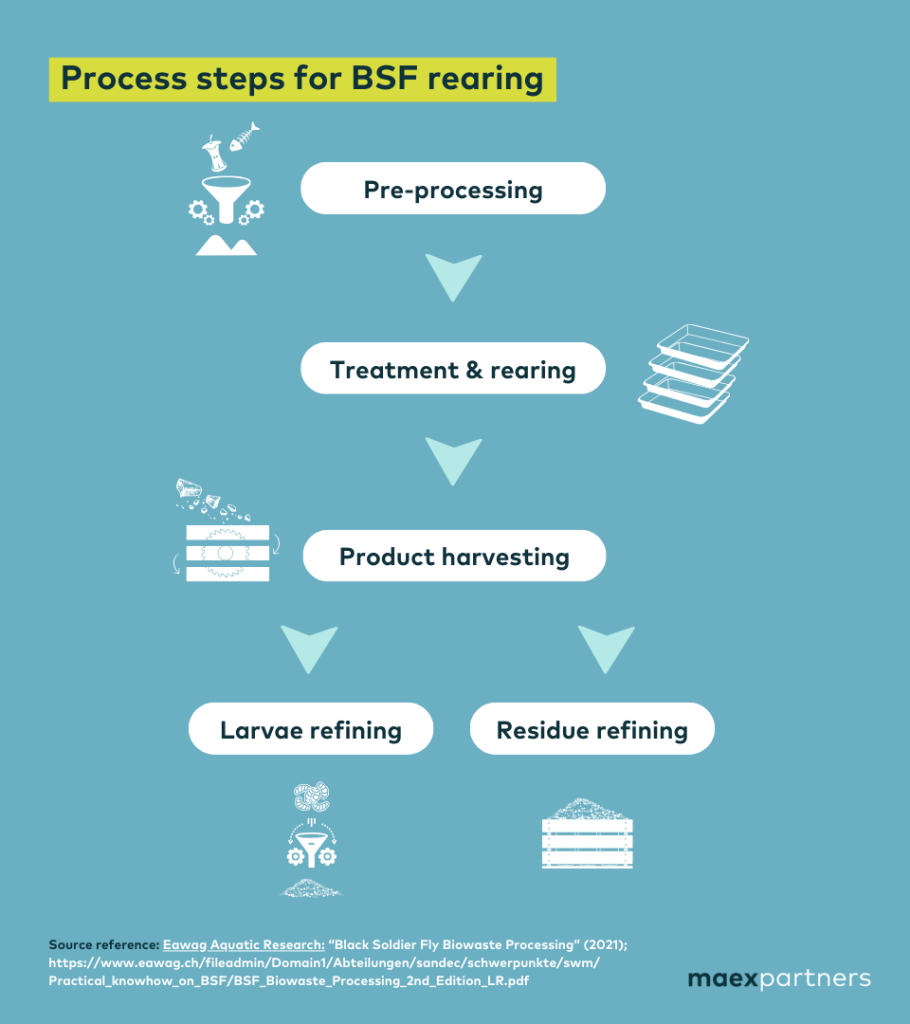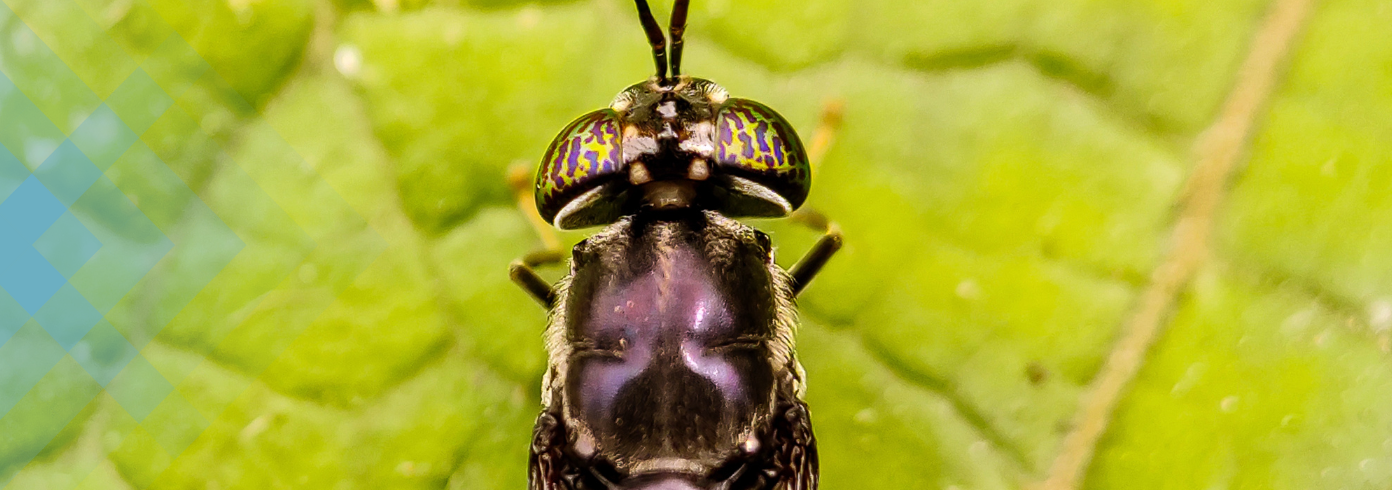Artikel
Feed the world – decoding the bug revolution
As the global population explodes and environmental concerns escalate, industries across the globe are faced with the challenge of meeting growing demands while minimizing ecological impact. Central to this challenge is the balance between nourishing our nutritional needs and preserving our planet’s delicate ecosystems. In this search for sustainable agriculture, insect rearing for animal feed has emerged as a possible groundbreaking offering promising alternatives to traditional practices such as vertical farming, precision agriculture, or plant-based alternatives.
BLACK SOLDIER FLIES – WHAT IS THE BUZZ ABOUT?
The nutrient-rich profile of black soldier fly (BSF) larvae, encompassing essential amino acids, fats, and minerals, further underscores their potential as a game-changing solution for the evolving needs of animal nutrition and biowaste composting. The lifecycle of black soldier flies begins with adult flies laying eggs on selected substrates, such as compost or organic waste. From these eggs hatch larvae, which rapidly consume organic matter and grow into nutrient-rich biomass. Temperature and environmental conditions play critical roles in this process, influencing development rates. The flies‘ ability to thrive on organic waste and their rapid growth make them valuable for sustainable waste management and alternative protein production.

Black soldier fly rearing facilities worldwide vary from small-scale operations to large commercial farms. European and North American facilities emphasize on sustainability, often integrating rearing into existing systems to create secondary by products. In Asia, particularly China and Thailand, the industry addresses food security and waste management challenges. African countries like Kenya and Nigeria see community-based initiatives utilizing locally available work force. Food processing giants like Tyson Foods and ADM have already heavily invested in BSF rearing companies such as Protix and InnovaFeed, opening the battle to be pioneers in this radically growing field.
REVOLUTION OR ROADBLOCK?
To dig even deeper into what’s behind utilizing insect rearing for animal food produce it is helpful to look at the most common arguments for and against it:
High Protein Content vs. Regulatory Challenges: The nutritional benefits of BSF larvae, providing a sustainable protein source, are likely more influential than regulatory challenges, which may be addressed over time with evolving policies. In the EU, the rearing of BSF has been classified under “Novel foods”, greenlighting the way ahead its use as animal feed.
Efficient Waste Conversion vs. Biosecurity Risks: The highly efficient conversion of organic waste into biomass addresses a critical environmental issue, while biosecurity risks such as disease outbreaks can be managed with proper protocols and measures. One possible way for such outbreak control is ensuring the entire rearing process in silos that can be segregated in case of possible contamination.
Low Environmental Impact vs. Resource Intensity: Due to less usage of land, water, and feed resources, the potential for lower environmental impact aligns with sustainability goals and may outweigh concerns related to resource intensity, especially if efficiency improvements are made over time.
Versatile Feedstock vs. Consumer Perception: The versatility in utilizing various organic waste streams enhances the adaptability of BSF larvae production, potentially outweighing initial consumer reluctance to accept insect-based products in animal feed, which may change with education and awareness. BSF larvae is already finding acceptance as a pet food alternative and being sought out as the new food treat for house animals.
Potential for Local Production vs. Limited Research: The fact that insect faming can be done locally addresses logistical and transportation issues, which could be more significant in the short term than the need for further research, as research can evolve and improve over time.
Summing up the key factors listed above, it can be perceived that the rearing of black soldier flies leans more towards being a revolution. The field is also still very ripe for research driven studies on the biochemistry of flies and its associated biomimicry processes. This can only further strengthen the collaboration between laboratory researchers and industrial collaborations backed with the government regulations to tackle the problems at hand.
ENVIRONMONTAL RESPONSIBILITY OR SMART BUSINESS MOVE?
The rearing of BSF flies offers unique opportunities and avenues to shape the food industry forward. Recapping, the feed for the flies stems from any form of organic waste ranging from agricultural produce, food waste from cities and industrial organic by-products that are now finding different ways to save space, time, and money on bio-degradation efforts. Next comes the technology to facilitate the rearing of flies. Low-cost setups can be used with readily available machinery such as a presser (oil output) or hot oven (dry output) based on the needs of the final product.

With more companies trying to go organic all the way out in their value chain with a key focus on sustainability, such mini rearing farms can serve to make valuable side stream incomes by ensuring close collaboration with other stakeholders forming a circular economy loop. The best example would be able to regularly sell industrial organic waste to such breeding farms and counter benefiting from being already part of this niche industry. Another interesting use case would be for cattle rearing industry giants to cut short their sourcing demands of soy from halfway across the world to a more protein rich and sustainable means of fodder in the form of black soldier flies.
The concept of rearing black soldier flies could be a compelling fit for any organization, particularly if they are based out of Europe or North America and already prioritize sustainability as part of the company vision. Leveraging existing regulatory frameworks and encountering minimal competition, form the two prongs to capitalize on market growth. Considering the substantial biowaste output generated daily by industrial processes, implementing a successful „Waste to Wealth“ strategy becomes not just sensible, but imperative. The current landscape demands reflection on how your industry can embrace this upcoming bug revolution, set to revolutionize waste composting and livestock feed practices.
If you are left wondering how to best participate in this technology with great potential for disruption, we suggest starting out with a proper strategy development – ranging from M&A to partnership or organic capability built-up cases – prior to making bold moves.
Contact us for an initial non-binding assessment and an exchange on a strategy tailored to your organization which can include market deep dives, demand scenario definition, potential evaluation, capability analysis, required technologies assessment, cost and investment modelling, but also decision-taking support, communication and change management.



